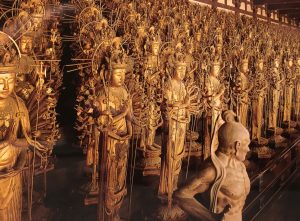Of all the many shrines and temples in Kyoto, and there seem to be hundreds, we have selected a few that are of particular interest, or which seem to offer something unique visually or historically. So I set my sights on two such places today. Luckily the route to the first was along the river. It was a very hot day, but there was a breeze along the path and some wildlife for entertainment. The carp sit absolutely still in the water under the bridges, barely moving yet facing upstream.
The first, Sanjusangen-do, more officially known as Rengeo-in Temple, was founded in 1164 by the charismatic warlord Taira no Kiyomori, and this paritcular temple dates from 1266. It is enormous — photos can’t capture it all — it’s almost 400 ft long, and is divided into 33 bays. Dedicated to the goddess of mercy, Kannon bosatsu, the number represents the 33 times that the goddess changed form to rescue mankind. The temple houses 1,001 statues of Kannon, each with a slightly different expression beneath their (faded) gilded exterior. Theres one gigantic seated statue paced at the center of those standing, and all are made of Japanese cypress. The Kannon were created over many years by over 80 different artists during the 12th and 13th C’s. There are 28 other images placed in a straight line in front of the rows of Kannon, each a guardian deities for protection. At either end are the Thunder God and the Wind God, who were worshipped to bring in good harvests. (Photos weren’t permitted, so these are snaps of postcards just for reference).
Next up was Fushimi Inari Taisha Shrine, the head shrine of the 30,000 Inari-sha shrines nationwide. It is at the western foot of Mt. Inari at the southern tip of Kyotos’ Higashiyama Sanju-Roppo (36 mountain range). Inari is the tutelary goddess of rice, Japan’s staple cereal, so it is easy to understand why the people here have been seeking Inari’s favor by erecting torii branded with their names. A path wends its way for 2 miles up the hillside to the shirne, passing through thousands of vermilion torii gates. From ancient times, the color vermilion has been considered to symbolize the life force and counteract spells. There are approximately 10,000 of these gates that have been offered by worshippers nationwide as a testament of their prayers and gratitude. (What this really means is that most every gate is sponsored. I was surprised by the one you see below, with English characters instead of Japanese). Toriis are infused with the meaning of “wishes will come through”. It was quite a climb and pretty crowded, but visually very arresting, so well worth the long walk.
After all that walking, I figured out the train and subway system and made my way over to the Nijo Castle, which was just closing, but my real purpose was to see Liz and Jonathan, who had just arrived in Kyoto! How wonderful to be reunited with family after such a very long time away. They arranged for a birthday dinner in the Pontocho district — a special Kaiseki meal — which consists of many small plates and dishes on a set plan and order. I will admit to skipping a couple courses — my adventurous spirit usually leaves me at the dinner table. But there was rice and sake, so it was all good. And then we went to a jazz bar called Hello Dolly for some whisky along the river. A long and delightful day.

















BEST. UPDATE. EVER. Yay reunions!!!!! I bet they MISS you!!!!
I LOVE that you got time with them.